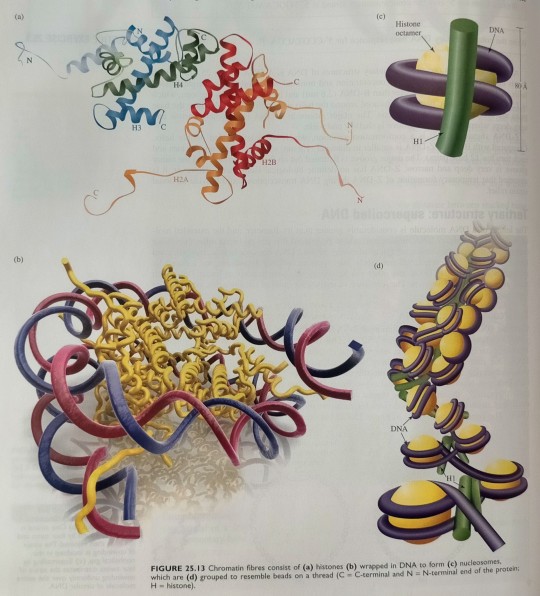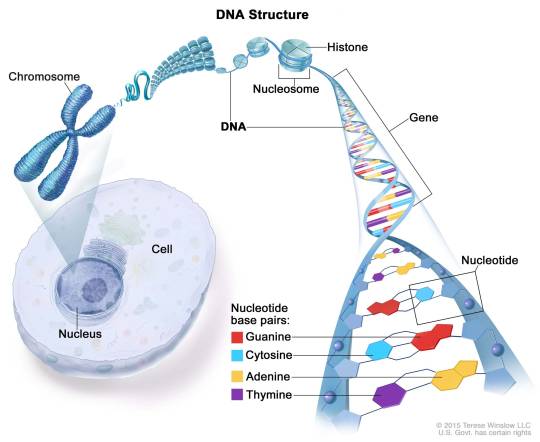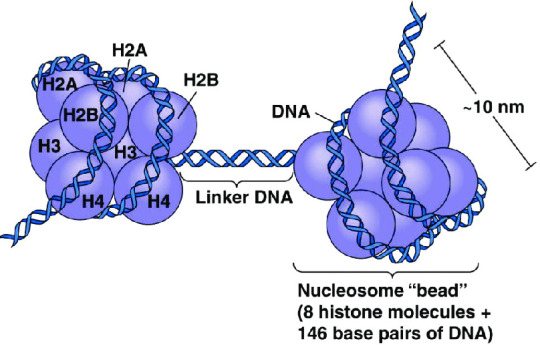#histone
Explore tagged Tumblr posts
Text

The Nucleosome: DNA's Fancy Packaging and Party Trick!
Imagine cramming two meters of yarn into a pea-sized box. Sounds impossible, right? Well, that's the impressive feat that cells pull off every single day with DNA! They use a clever structure called the nucleosome to pack this massive genetic blueprint into the tiny nucleus.
The journey began in 1974 when Don and Ada Olins, peering through an electron microscope, spotted repeating beads – the first glimpse of nucleosomes. Roger Kornberg, building upon this observation, proposed the now-iconic "subunit theory," envisioning DNA wrapped around histone protein cores. This theory, later solidified by Pierre Oudet's term "nucleosome," laid the groundwork for further exploration. The 1980s witnessed a flurry of activity, with Aaron Klug's group using X-ray crystallography to reveal the left-handed superhelical twist of DNA around the histone octamer. But the true masterpiece arrived in 1997 when the Richmond group, armed with advanced techniques, unveiled the first near-atomic resolution crystal structure of the nucleosome. This intricate map, showcasing the precise interactions between DNA and histones, remains a cornerstone of our understanding.
The Players:
DNA: The star of the show, carrying our genetic code in the form of a double helix.
Histones: Protein spools around which DNA tightly winds. Imagine eight of them forming a core, like a mini-protein drum set.
Linker DNA: Short stretches of DNA connecting the spools, like the spaces between beads on a necklace.
The Steps:
Wrap and Roll: Picture DNA gracefully wrapping around the histone core, like thread around a spool. Each nucleosome holds about 146 base pairs of DNA, making about 1.67 turns.
Connect and Repeat: Linker DNA bridges the gap between nucleosomes, forming a "beads-on-a-string" structure. Think of it as pearls strung between the spools.
Compact and Condense: This repetitive unit folds further, creating intricate 30-nanometer fibers. Imagine these as twisted strands of pearls!
Here's the coolest part: histones aren't static. They can be chemically modified, like adding or removing phosphate groups. These modifications act like tiny flags that tell the cell how tightly to wrap the DNA, essentially throwing a "party" for specific genes by making them more accessible. This fine-tuning allows cells to respond to their environment and express the right genes at the right time. Understanding the nucleosome model is crucial for unraveling the mysteries of gene regulation and diseases like cancer. By studying how modifications affect nucleosome structure and gene access, scientists can develop new therapies to target specific genes and potentially treat diseases at the root cause.
While the nucleosome model is the foundation, the story gets even more intriguing. Different histone types and modifications create variations, influencing chromatin structure and function. Think of it as different music genres influencing the dance moves! Additionally, other proteins interact with the nucleosome, adding another layer of complexity to this fascinating choreography.
The nucleosome model is more than just a neat way to package DNA. It's a testament to the intricate dance between molecules that orchestrates life's processes. By understanding this fundamental structure, we gain deeper insights into cellular function, paving the way for advancements in medicine and beyond.
Remember, this is just the beginning! The world of nucleosomes and chromatin is vast and ever-evolving. So, keep exploring, keep questioning, and keep dancing to the rhythm of DNA!
#molecular biology#biology#science sculpt#life science#science#dna#biotechnology#genetics#Histone#Nucleosome#chromatin
9 notes
·
View notes
Text
Abstract Histone deacetylases is a family of enzymes pivotal in regulating numerous crucial cellular processes in both plant and animal cells. Plant histone deacetylases have been considerably less investigated in comparison to their human counterparts. This study aims to provide an in-depth characterization of histone deacetylases in two model plant proteins-species Arabidopsis thaliana and Oryza sativa. Phylogenetic analysis of their relationship to known human homologs has revealed their close relation to three classes of human histone deacetylases. Notably, the highest sequence homology among histone deacetylases from different evolutionary origins was observed between human HDAC6 and A. thaliana HDA5 (43.6% homology). Structural alignment results highlighted the conservation of catalytic domains and demonstrated a high activity of inhibitors against both histone deacetylases. Ligand-protein docking studies suggested a high potency of human histone deacetylase inhibitors against A. thaliana HDA5. These findings suggest the potential efficacy of human histone deacetylase inhibitors in modulating plant histone deacetylases, thereby enhancing growth regulation, development, and stress resistance in plants.
#histonedeacetylases#Arabidopsisthaliana#Oryzasativa#homologyclassification#moleculardocking#inhibitors#histone#Arabidopsis#Oryza
0 notes
Text
The fundamental structural unit of chromatin is the nucleosome, an assembly consisting of a group of certain proteins, called histones (designated H1, H2A, H2B, H3 and H4, see figure 25.13a), wrapped in DNA (figure 25.13b). (...) In a nucleosome, B-DNA is wound around the histone unit by about 1.8 coils (figure 25.13b,c). (...) The nucleosomes are further folded to form a filament, with a diameter of ~30 nm, which has been proposed to have the structure down in figure 25.13d.

"Chemistry" 2e - Blackman, A., Bottle, S., Schmid, S., Mocerino, M., Wille, U.
#book quotes#chemistry#nonfiction#textbook#dna#chromatin#nucleosome#protein#deoxyribonucleic acid#bdna#histone#filament#folding
1 note
·
View note
Text

when the guy you just met is surprised his bluff worked too
#dragon age#dragon age spoilers#dragon age: the veilguard#dragon age: the veilguard spoilers#da:tv#da: tv spoilers#da:tv spoilers#animation#hoiist animated after many decades#ch: histon#rook#dorian pavus#dragon age the veilguard
142 notes
·
View notes
Text

Emmrich and Histon for @hoiist
first time getting to try my hand at Veilguard characters and I had a lot of fun with it
113 notes
·
View notes
Text
I gotta hand it to Augustine, when it came time for him to disprove astrology, he decided to do so using twin studies, of all things
23 notes
·
View notes
Text
it's literally such a red flag if someone's into primatology and epigenetics
#ok i mean i'm sure there's a perfectly normal academic researcher doing some sort of comparative work on macaque histone remodeling factor#but like. if it's in someone's twitter profile as shit they Like To Talk About#epigenetics in general is so annoyingly prevalent as a warning sign for someone who's really into like. evopsych nightmare shit#fuckers always making horrible blog posts about how high-value women have less methylated DNA.#box opener
12 notes
·
View notes
Text

TSRNOSS. Page 196.
#blind cave fish#cornea#opacification#lysozyme#blood viscosity#diabetes#hypokalaemia#immunity#histones#oxidation#DNA#hypercoiling#photosynthetic efficiency#chloroplast#light scattering#viruses#magnesium ion#hexokinase#RNA#phosphodiester bond#alkali damage#DNA polymerase#protein synthesis#methionine#satyendra#notebooks#manuscripts
3 notes
·
View notes
Text
Hello everybody I am popping on for my first art post in a blue moon

This one took like, 1 hour 10 minutes or something idk I never really bothered enough to count
23 notes
·
View notes
Text
Histone Modifications
Hello, hello! Today's topic is histone modifications. We are continuing on with the epigenetics theme after my previous educational post about DNA methylation. As described in that post, epigenetics is the study of heritable genetic modifications without a change in DNA sequence (Takuno & Gaut, 2012). Similarly to DNA methylation, histone modifications affect gene expression through regulation of accessibility of the DNA for transcription (Bartova et al, 2008). But before we get into these modifications, let's go over a bit of background information!
What is a histone, anyway? A histone is a type of protein involved in DNA compaction and organization. In order to fit a genome's worth of DNA into the nucleus of a cell, that stuff needs to be extremely tightly packed! Histones help with this by forming an octomer called a nucleosome, which the DNA wraps around. These nucleosomes then coil together to form a fiber known as chromatin, which goes on to make up a chromosome. When the chromatin is less tightly packed, it is known as euchromatin and it is available for transcription (Bartova et al, 2008). When it is more tightly packed, it is known as heterchromatin, and polymerase proteins cannot access and transcribe the DNA (Bartova et al, 2008). Histone modifications regulate the transition between heterochromatin and euchromatin (Bartova et al, 2008).

(Above image from humanoriginproject.com)

(Above image from Caputi et al, 2017)
The octomer core of a nucleosome is made up of two copies of each of four types of histones: H2A, H2B, H3, and H4 (Marino-Ramirez et al, 2017). Each of these histones includes an N-terminal tail structure, which is the main site of modification (Marino-Ramirez et al, 2017). The tails are modified through addition and removal of certain functional groups or other small structures. Types of modifications include acetylation by histone acetyltransferases, methylation by histone methyltransferases, phosphorylation by kinases, and ubiquitination (Marino-Ramirez et al, 2017). All of this information is used for naming specific histone modifications: Which histone is modified, which amino acid of the histone tail the modification is on, what type of modification is made, and in what amount. For example, H3K9me2 is the name for di-methylation of the 9th Lysine on an H3 histone's tail.
Some important histone modifications and their effects include:
H3K9me2: transcriptional activation + maintenance of CHG DNA methylation in plants
H3K9me3: transcriptional repression
H3K9ac: transcriptional activation
H3K4me1 & H3K4me3: transcriptional activation
H3K27me3: transcriptional repression
H4K16ac: transcriptional activation
H3S10p: DNA replication-related chromatin condensation
(He & Lehming, 2003)
Important Terms: histone, nucleosome, heterochromatin, euchromatin, transcription, epigenetics
5 notes
·
View notes
Text
youtube
#Metabolite regulation of epigenetics in cancer involves key areas such as cancer metabolism#tumor microenvironment#epigenetic modifications#DNA methylation#histone acetylation#chromatin remodeling#oncogene activation#tumor suppressor silencing#metabolic pathways#tumor progression#hypoxia-induced epigenetics#acetyl-CoA dynamics#S-adenosylmethionine (SAM)#alpha-ketoglutarate (α-KG)#fumarate accumulation#lactate influence#therapeutic targeting#Youtube
0 notes
Text
Stable or heritable DNA methylation and histone modifications have now been linked with specific abiotic stresses (Figure 24.15).

"Plant Physiology and Development" int'l 6e - Taiz, L., Zeiger, E., Møller, I.M., Murphy, A.
#book quotes#plant physiology and development#nonfiction#textbook#dna#methylation#histone#abiotic stress#biotic stress#gene expression#phenotype
0 notes
Text

when your boyfriend is the hornest man at the table
#dragon age#dragon age: the veilguard#dragon age fan art#emmrich volkarin#emmrook#emmrich x rook#lord of fortune rook#ch: histon#hes about to marry that man#sketch
88 notes
·
View notes
Text
Yeni Sinaps Türü Bulundu
Yeni Sinaps Türü Bulundu Bilim insanları sinir hücrelerimizde daha önce bilinmeyen sinaps türü buldular. Bu nöronsal devreler iyi bilinen sinir uçlarında değil, hücre yüzeyindeki küçük kıl benzeri kirpiklerde yer alıyor. Bu sinapslar serotonin gibi nörotransmitterler tarafından etkinleştirildiklerinde, doğrudan doğruya hücre çekirdeğindeki değişiklikleri tetikliyor ve DNA’nın okunmasını da…
#akso-dendrit#dendrit#hipokampus#histon#histonlar#kromatin#nörokimyasal#örotransmit#sinaps#sinapsin dendrit#Yeni Sinaps Türü#Yeni Sinaps Türü Bulundu
1 note
·
View note
Video
Translating the Code: A Tale of Tails by National Library of Medicine Via Flickr: Alternate Title(s): Tale of tails Series Title(s): NIH director's Wednesday afternoon lecture series Contributor(s): Allis, C. David., National Institutes of Health,(U.S.). Medical Arts and Photography Branch., National Institute of General Medical Sciences (U.S.) Publication: [Bethesda, Md. : Medical Arts and Photography Branch, National Institutes of Health, 2001] Language(s): English Format: Still image Subject(s): Histones Genre(s): Posters Abstract: Predominantly blue poster with multicolor lettering announcing lecture by C. David Allis, Oct. 2001. Series and sponsor information at top of poster. Visual image may be a representation of histone. Title and speaker information on left side of poster. Lecture date, time, and location near bottom of poster. Extent: 1 photomechanical print (poster) : 82 x 46 cm. Technique: color NLM Unique ID: 101455873 NLM Image ID: C02741 Permanent Link: resource.nlm.nih.gov/101455873
#Medical Arts and Photography Branch#Photomechanical Print#Poster#NIH director's Wednesday afternoon lecture series#National Institute of General Medical Sciences#Histones#C. David Allis#code#Harry F. Byd Jr.#Biochemistry#Molecular Genetics#Microbiology#Center for Cell Signaling#University of Virginia Health Science Center#Still Image#Public Domain#Free Images#Prints and Photographs#National Library of Medicine#NLM#IHM#National Institutes of Health#NIH#Archives of Medicine#NLM Digital Collection#flickr
0 notes


